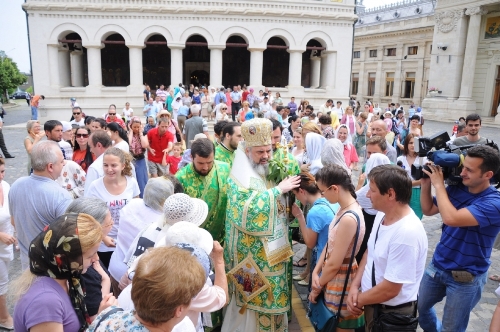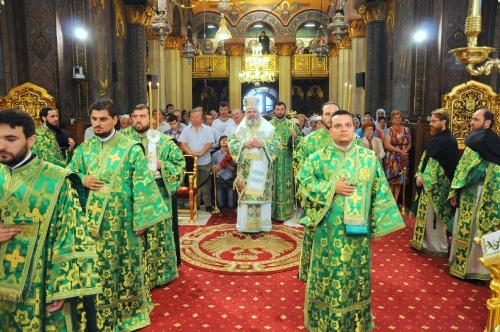 On 23 June 2013, the Orthodox Christians celebrate the Descend of the Holy Spirit, a feast also known as the Pentecost. The Church history mentions the feast as the moment of the Descend of the Holy Spirit over the Apostles as tongues of fire.
On 23 June 2013, the Orthodox Christians celebrate the Descend of the Holy Spirit, a feast also known as the Pentecost. The Church history mentions the feast as the moment of the Descend of the Holy Spirit over the Apostles as tongues of fire.
The Divine Liturgy was celebrated by His Beatitude Daniel, Patriarch of the Romanian Orthodox Church, at the Patriarchal Cathedral of Bucharest, assisted by a group of priests and deacons, in the presence of many faithful.
After reading the Gospel pericope of Saint John the Evangelist (John 7:37-58; 8:12), the Patriarch of Romania delivered a sermon in which he emphasised the spiritual meaning of the Evangelical pericope: “Both the Apostle and the Gospel of the day show us the work of the Holy Spirit whom Jesus Christ, our Lord, sends together with God-the-Father over His Saint Disciples and Apostles. The Saviour shows us in the Gospel that the one who believes in Him will receive a special gift, namely rivers of living water will flow from him to Heaven. This means, as the Gospel says, the presence and work of the Holy Spirit in the faithful man. The Holy Spirit comes into the world through the humanity consecrated, deified, and glorified of Christ in the Most Holy Trinity”.
His Beatitude has also spoken to over 500 faithful present about the purpose of sending the Holy Spirit into the world: “This coming of the Holy Spirit is designed to deify the disciples so that they should begin preaching in Jerusalem and then to the nations all over the world. The tongues oh fire are a symbol of the work of the Holy Spirit who inspires the disciples. They do not speak in accordance with the human wisdom, but convey by voice or by writing the thought and work of God. The tongues of fire are the divine languages, the languages by which the God-the-Word shown in the Holy Scriptures is conveyed, and especially the Gospel of Christ. The tongues of fire are not languages that convey human, earthly wisdom, but the fact that this fire comes from Heaven showing the divine, heavenly, eternal teaching of the Saints Apostles”.
 This day represents the constitution of the Church founded by Jesus Christ, our Saviour, and re-establishing of the man on the way of holiness. The foundation of the Church was done in several stages. It began with the Incarnation of the Saviour and finished with the Descent of the Holy Spirit, the Patriarch of Romania also explained: “The Church has as head the Christ, God-the-Man who unites the divine and human life into one single person. He prepares the disciples as the leaders of the Church and deifies them in several stages, but the full deification of the disciples is the Descent of the Holy Spirit over them. Saint Simeon the Thessalonian says that he ordained them deacons when he called them to service, and priests when he told them: “Take Holy Spirit: those to whom you will forgive the sins will be forgiven” and now he ordains them bishops namely in the fullness of the grace through the Descent of the Holy Spirit at the Pentecost. What was the divine-human life in a single person is extended to several persons in a Church now through the work of the Holy Spirit. Therefore, Christ is the Head of the Church, and the Church is His Body made up of all the persons who believe in Christ, are baptised in the name of the Most Holy Trinity, and have spiritual life received from the Holy Spirit in which they grow spiritually”.
This day represents the constitution of the Church founded by Jesus Christ, our Saviour, and re-establishing of the man on the way of holiness. The foundation of the Church was done in several stages. It began with the Incarnation of the Saviour and finished with the Descent of the Holy Spirit, the Patriarch of Romania also explained: “The Church has as head the Christ, God-the-Man who unites the divine and human life into one single person. He prepares the disciples as the leaders of the Church and deifies them in several stages, but the full deification of the disciples is the Descent of the Holy Spirit over them. Saint Simeon the Thessalonian says that he ordained them deacons when he called them to service, and priests when he told them: “Take Holy Spirit: those to whom you will forgive the sins will be forgiven” and now he ordains them bishops namely in the fullness of the grace through the Descent of the Holy Spirit at the Pentecost. What was the divine-human life in a single person is extended to several persons in a Church now through the work of the Holy Spirit. Therefore, Christ is the Head of the Church, and the Church is His Body made up of all the persons who believe in Christ, are baptised in the name of the Most Holy Trinity, and have spiritual life received from the Holy Spirit in which they grow spiritually”.
After the celebration of the Divine Liturgy, His Beatitude Patriarch Daniel celebrated, assisted by a group of priests and deacons, a special service named the Pentecost Vespers, when seven prayers were said, four of them in a loud voice and three in a low voice. Also blessed were the walnut leaves symbolically remembering the tongues of fire through which the grace of the Holy Spirit was shown working in the disciples of Christ whom He sent to announce His Gospel in different languages, namely to different peoples, up to the edge of the earth, beginning from Jerusalem.
This is the third special Vesper celebrated during the church year. The first two are celebrated on the Holy Friday, when the Holy Epitaph is put in the middle of the church, and on the Sunday of the Holy Easter, at noon, named, according to tradition, the “Second Resurrection”.
To end with, the Primate of the Romanian Orthodox Church offered little crosses to the faithful present representing the feast of the day.
